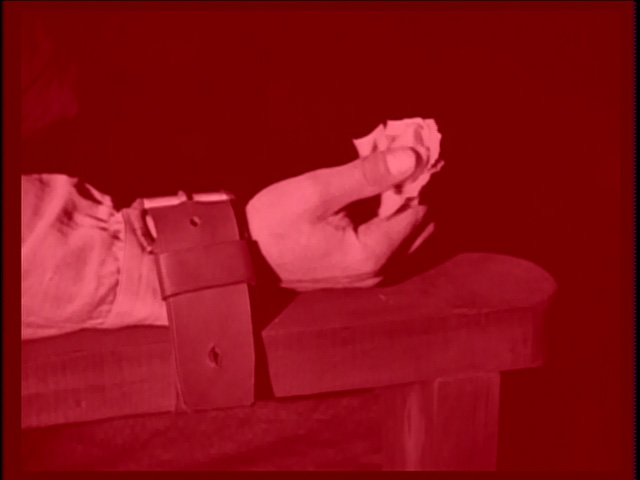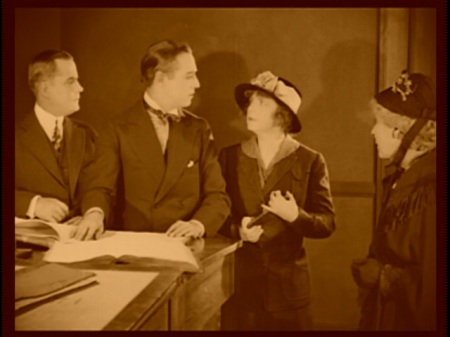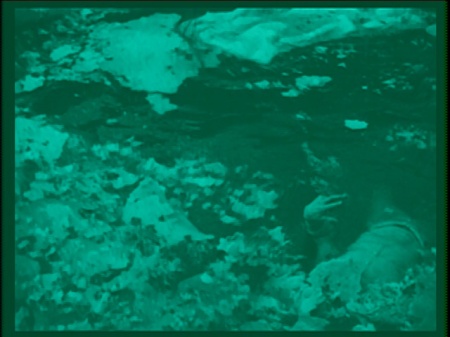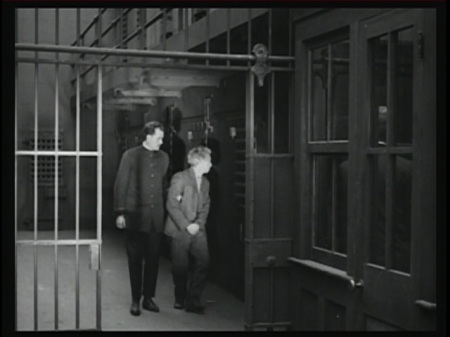Cecil B. DeMille takes us into the head of Raymond Hatton’s embezzler in an intense narrative of guilt, conscience and self-absorption. Terrified of being caught, Hatton manages to fake his own death but the long arm of the law and his own inner voices do not let him forget his crimes.
Home Media Availability: Released on DVD.
No one will ever know!
The tale of Cecil B. DeMille’s 1910’s career often goes as follows: In 1918, Cecil B. DeMille took a stab at artistry with a daring film called The Whispering Chorus. The downbeat material made audiences stay home in droves and, his artistic dreams dashed, DeMille gave himself over to kitsch and hokum.
It’s the story of the public crushing an artist. It’s a dramatic narrative. It is also utterly false.
The Whispering Chorus made $242,000 on a $72,000 budget. Solidly profitable, I would say. Other DeMille releases of 1918 grossed between $200,000 and $280,000, putting The Whispering Chorus firmly in the median for the year.
Plus, we are neglecting the fact that DeMille liked making crowdpleasers. When he had his own production company and was the undisputed boss, what did he make? More Whispering Choruses? Hardly! A time travel cornball, a Russian romance, a devout religious picture and a social commentary/kids-in-prison film. (The Road to Yesterday, The Volga Boatman, King of Kings and The Godless Girl, respectively.)
The Whispering Chorus was a little out of DeMille’s line but not by much. He had already dabbled in social films with Kindling and he would do it again a few more times in the ensuing decades.
So, how does this film hold up now that the juicy narrative of an artist scorned has been debunked. Looks like we are going to find out.
John Tremble (Raymond Hatton) is a wage slave who keeps the books for a large construction company. He doesn’t make much but his loyal wife, Jane (Kathlyn Williams), manages to keep the household above water. That’s just not good enough for John. He is often plagued by conflicting thoughts that encourage him to do both right and wrong.
This glimpse into John’s head is supplied by double exposed heads. There is an evil voice (Walter Lynch), a mocking face (Gustav von Seyffertitz) and a good face (Edna Mae Cooper), each encouraging him to go a different way. While the idea of an angel and devil on each should is familiar to any Looney Toons viewer, DeMille’s direction and Hatton’s acting make this conflict very poignant indeed.
We are quickly introduced to John’s fatal flaw: he always wants to have his cake and eat it too. Early in the film, he throws a tantrum because his hat and coat are getting shabby. Jane flees from his rant and John’s mother (Edythe Chapman) encourages him to make amends by buying Jane a new dress she has been longing for. John sets out with the best of intentions but he runs into a friend who invites him to a friendly game of cards. The voices urge him to play. When he wins, he can afford both the dress and a new overcoat.
The inevitable occurs. John loses all the money and returns to his flat empty handed. He makes up an excuse but Jane later finds a gambling chip in his pocket.
Humiliated, John’s mind now turns to his employer’s money. He has a position of trust and he has been a loyal employee. Why would anyone notice just a bit of money missing from his ledger? John cooks the books and pockets the cash.
What John had not counted on was a certain George Coggeswell (Elliott Dexter), an ambitious member of the legislature who is heading up a corruption investigation. As it happens, John’s place of employment is accused of graft and George has the authority to audit the books.
John panics. He can’t return the money because he has already spent it on gifts for his mother and Jane. In blind panic, he flees to a small fishing shack and considers his position.
An unfortunate coincidence gives him an idea. While fishing, he pulls the body of one Edgar Smith out of the river. What if…
John dresses the corpse in his clothing and smashes its face. Then he adds the masterstroke that is also his undoing. He is not happy to think that everyone will know he is an embezzler so he plants a note on the corpse stating that Edgar Smith has been blackmailing him to cook the books but he has refused. If anything happens to John Tremble, Edgar Smith is the culprit.
Overjoyed at his martyrdom, John sets out for parts unknown. What he had not counted on, though, is that the cruel murder of a fearless bookkeeper would surely make the news and mobilize the police to find the killer.
George breaks the news to Jane and takes her to identify the body. It is too battered and decayed for her to truly recognize it but she is able to testify that all the clothing and personal effects belonged to John. George pities Jane and is immediately attracted to her. He asks her to work as a secretary at his office and Jane, who must now support John’s mother, happily accepts.
While poor Jane is undergoing her ordeal, John is enjoying his new clandestine life. Wine, women and song are his– until the cash runs out, that is. White collar jobs will ask for identification so he is forced to take a job as a longshoreman. On his first day, he is crushed under some barrels. Unable to go to the hospital, his leg cannot heal properly and he develops a pronounced limp.
Meanwhile, George’s political career has blossomed. He has been elected governor. He proposes to Jane but she is afraid to accept as she does not wish to hurt John’s mother.
John tries to get news of his mother but this only alerts the police and he is nearly arrested. John takes a job on a China-bound ship. Meanwhile, Jane and George are given maternal permission to marry and they do so. Two years pass and Jane is expecting their first child.
John’s complete self-absorption once again trips him up. Nearly five years have passed but he expects both his mother and Jane to be awaiting the prodigal’s return. His shocking appearance (scarred, limping, tattered) causes the neighbors to call the police and his ill mother dies before she can identify him as her son.
John now finds himself in a singular position. As Edgar Smith, he is on trial for murdering himself.
The Whispering Chorus is an intense film that really packs a wallop. The gorgeous, moody lighting, the dark, uncompromising view of humanity and the distinctly unsympathetic protagonist make this a sort of proto-proto-noir. If I wanted to start a rumor that a young Raymond Chandler, W.R. Burnett or James M. Cain wrote the story on the sly, I’ll bet I could get people to believe me. (The screenplay was based on a story by Perley Poore Sheehan and adapted by Jeanie Macpherson.)
Critics were divided on the film. Variety praised it as a masterpiece while Motion Picture Classic recommended watching Keystone films instead because (oh my!) dark films are just so very horrid. Don’t you just want to treat that critic to an evening of Waxworks, Cabinet of Dr. Caligari and Nosferatu?
Raymond Hatton was a regular in DeMille’s films but he had always played supporting and character roles. Short, slight, long of nose and weak of jaw, Hatton did not look like a movie star and leading roles were rare. To be honest, I was not sure if he could pull it off. His performance in The Little American was just awful and he overdid it again in A Romance of the Redwoods. I have to say, though, he is really marvelous in the lead here. His weak appearance is ideal for communicating John’s character flaws. His transformation from dapper bookkeeper to gaunt tramp is some of the best physical acting of the silent screen. His white wig is not entirely convincing but his face is a marvel.
Kathlyn Williams was ten-year industry veteran at this point and had starred in serials, shorts and serious drama. She is generally good in the film, though she does carry on a bit during the grieving scenes. Elliott Dexter does well enough but his character is pretty much a one-dimensional do-gooder. It’s easy to see why Jane fell for him but we are glad that he is not the hero.
Secondary acting honors must go to Noah Beery, who has a brief but colorful role as the longshoreman who befriends John and helps him evade the police. It’s a trademarked Beery Lovable Lout but the character suits the story and adds a bit of comedy without upsetting the balance of the film.
I can’t believe I am typing this but I also thought Julia Faye was good as the lady of the night John meets in China. Faye was DeMille’s mistress and he put her in everything. Everything. At least he had the good sense not to grant her leading roles and her screen time is usually limited to a few scenes. Faye’s performances are generally to be endured rather than enjoyed but her acting in The Whispering Chorus strikes just the right note and her somewhat goofy flirtations are perfect for symbolizing just how low John has fallen.
These scenes are cross-cut with Jane and George’s marriage ceremony. Throughout the film, DeMille using cross-cutting the compare and contrast John’s fall with Jane’s rise. While definitely possessing a dramatic flair, these comparisons are not heavy-handed or preachy. We are left to judge for ourselves.
DeMille allows John to become tangled in a moral knot. Now, anyone who has seen enough movies knows that 95% of the time (particularly in classic film), the character is going to get let out of his knot somehow. The Whispering Chorus is in the 5%, another reason why it is often compared to film noir. John cannot save himself without destroying both George and Jane.
The climax of The Whispering Chorus is sometimes described as Victorian but I would argue that the danger to George and Jane would be just as severe today. Think about it. The noble governor who was elected on his clean character and crusading behavior is discovered to be in a bigamous marriage. His wife’s first husband is an embezzler. Oh, and just where did John get that body? Found him? Ha! Murdered him, I shouldn’t wonder. Are we really to believe that George, the investigator on the case, didn’t have anything to do with this?
Oh yeah, no reporter is going to touch that. George Coggeswell would be under investigation in two seconds flat.
If you have never seen DeMille’s ‘teen work, The Whispering Chorus may seem out of character with its moody lighting and small scale. In fact, DeMille was an incredibly prolific worker during this period and he released dozens of so-called program pictures (that is, lower budget, smaller scale). He was also noted for his “Rembrandt lighting,” which is rather gorgeous. You can see more of it in The Golden Chance and The Cheat. I also enjoyed the artistry of the title cards. The whispering voices are given their very own whispery lettering style.
The film is quite stylized, with its spectral heads and eerie-realistic scenery. The characters also actively engage in symbolic behavior. George carefully re-balances the scales on a statuette of lady justice. John goes to the electric chair with Jane’s flower in his hand, crushing it as the switch is thrown. His mother reads passages in the Bible regarding the prodigal son as her own prodigal approaches. It all has a rather Germanic flavor and it may sound hackneyed in the description but it works rather well on the screen.
The one scene that is properly “DeMille” is the Chinese New Year scene. Fireworks, crowds and giant dragons dance across the screen, all perfectly lit.
Cecil B. DeMille’s older brother, William, was also a director noted for his sensitive character studies. I love William deMille and his Miss Lulu Bett is one of my favorite silent films. What I do not like, though, is how his talent is used as a critical cudgel to beat Cecil. I object because a) the two men had almost nothing in common as directors, b) but we can’t say for sure because so few of William’s films survive while almost all of Cecil’s movies are extant. (I also object to Novarro being used to bash Valentino and Keaton being used to bash Chaplin.) In any case I think The Whispering Chorus is an excellent answer to critics who wish to create a fraternal feud.
While the colorful story behind The Whispering Chorus is false, it is still one of the highlights of DeMille’s early career. The story is tight, the moral knots are juicy and Raymond Hatton gives the performance of a lifetime.
Movies Silently’s Score: ★★★½
Where can I see it?
The Whispering Chorus has been released on DVD as a double feature with Old Wives for New. The film is accompanied by an excellent chamber score by the Mont Alto Motion Picture Orchestra.
☙❦❧
Like what you’re reading? Please consider sponsoring me on Patreon. All patrons will get early previews of upcoming features, exclusive polls and other goodies.
Disclosure: Some links included in this post may be affiliate links to products sold by Amazon and as an Amazon Associate I earn from qualifying purchases.


















